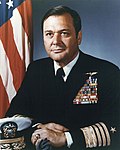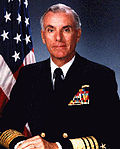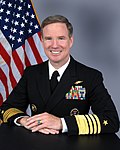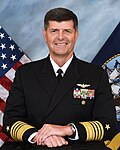| No. | Image | Name | Tenure | Post(s) held after VCNO tenure |
|---|
| Began | Ended |
|---|
| 1 |  | VADM (ADM) Frederick J. Horne | 26 March 1942 | 2 September 1945 | Retired, 1945
Promoted to admiral on 29 January 1945 |
| 2 |  | ADM Richard S. Edwards Jr. | 1945 | 1946 | Commander, Western Sea Frontier (1946–1947)
Commander, Pacific Reserve Fleet (1946–1947)
Retired, 1947 |
| 3 |  | ADM DeWitt Clinton Ramsey | 15 January 1946 | 3 January 1948 | Commander in Chief, U.S. Pacific Command (1948–1949)
Commander in Chief, U.S. Pacific Fleet (1948–1949
High Commissioner, Trust Territory of the Pacific Islands (1948–1949)
Retired, 1949 |
| 4 |  | VADM Arthur W. Radford | January 1948 | May 1949 | Commander in Chief, U.S. Pacific Command (1949–1953)
Commander in Chief, U.S. Pacific Fleet (1949–1953)
High Commissioner, Trust Territory of the Pacific Islands (1949–1951)
Chairman of the Joint Chiefs of Staff (1953–1957)
Retired, 1957 |
| 5 |  | VADM John D. Price | 1949 | 1950 | Retired, 1950
Promoted to admiral upon retirement |
| 6 |  | ADM Lynde D. McCormick | 1950 | 1951 | Commander in Chief, U.S. Atlantic Command (1951–1954)
Commander in Chief, U.S. Atlantic Fleet (1951–1954)
Supreme Allied Commander Atlantic (1952–1954)
Retired, 1954 |
| 7 |  | ADM Donald B. Duncan | 1951 | 1956 | Retired, 1956 |
| 8 |  | ADM Harry D. Felt | 1956 | 1958 | Commander in Chief, U.S. Pacific Command (1958–1964)
Retired, 1964 |
| 9 |  | ADM James S. Russell | 21 July 1958 | September 1961 | Commander in Chief, Allied Forces Southern Europe (1961–1965)
Retired, 1965 |
| 10 |  | ADM Claude V. Ricketts | 25 September 1961 | 6 July 1964 | Died in office, 1964 |
| 11 |  | ADM Horacio Rivero, Jr. | July 1964 | January 1968 | Commander in Chief, Allied Forces Southern Europe (1968–1972)
Retired, 1972 |
| 12 |  | ADM Bernard A. Clarey | | December 1970 | Commander in Chief, U.S. Pacific Fleet (1970–1973)
Retired 1973 |
| 13 |  | ADM Ralph W. Cousins | 1970 | 1972 | Supreme Allied Commander Atlantic (1972–1975)
Commander in Chief, U.S. Atlantic Command (1972–1975)
Commander in Chief, U.S. Atlantic Fleet (1972–1975)
Retired, 1975 |
| 14 |  | ADM Maurice F. Weisner | 1972 | 1973 | Commander in Chief, U.S. Pacific Fleet (1973–1976)
Commander in Chief, U.S. Pacific Command (1976–1979)
Retired, 1979 |
| 15 |  | ADM James L. Holloway III | September 1973 | 1974 | Chief of Naval Operations (1974–1978)
Retired, 1978 |
| 16 |  | ADM Worth H. Bagley | June 1974 | July 1975 | Retired, 1975 |
| 17 |  | ADM Harold E. Shear | 1975 | 1977 | Commander in Chief, Allied Forces Southern Europe (1978–1980)
Retired, 1980
Administrator of the Maritime Administration (1981–1985) |
| 18 |  | ADM Robert L. J. Long | July 1977 | April 1979 | Commander in Chief, U.S. Pacific Command (1979–1983)
Retired, 1983 |
| 19 |  | ADM James D. Watkins | April 1979 | 1981 | Commander in Chief, U.S. Pacific Fleet (1981–1982)
Chief of Naval Operations (1982–1986)
Retired, 1986
Secretary of Energy (1989–1993) |
| 20 |  | ADM William N. Small | 1981 | 1983 | Commander in Chief, U.S. Naval Forces Europe (1983–1985)
Commander in Chief, Allied Forces Southern Europe (1983–1985)
Retired, 1985 |
| 21 |  | ADM Ronald J. Hays | 1983 | 1985 | Commander in Chief, U.S. Pacific Command (1985–1988)
Retired, 1988 |
| 22 |  | ADM James B. Busey IV | September 1985 | March 1987 [3] | Commander in Chief, U.S. Naval Forces Europe (1987–1989)
Commander in Chief, Allied Forces Southern Europe (1987–1989)
Retired, 1989
Administrator of the Federal Aviation Administration (1989–1991)
Deputy Secretary of Transportation (1991–1992) |
| 23 |  | ADM Huntington Hardisty | March 1987 | 1988 | Commander in Chief, U.S. Pacific Command (1988–1991)
Retired, 1991 |
| 24 |  | ADM Leon A. Edney | August 1988 | May 1990 | Supreme Allied Commander Atlantic (1990–1992)
Commander in Chief, U.S. Atlantic Command (1990–1992)
Retired, 1992 |
| 25 |  | ADM Jerome L. Johnson | May 1990 | July 1992 | Retired, 1992 |
| 26 |  | ADM Stanley R. Arthur | 6 July 1992 | 1995 | Retired, 1995 |
| 27 |  | ADM Joseph W. Prueher | April 1995 | 1996 | Commander in Chief, U.S. Pacific Command (1996–1999)
Retired, 1999
U.S. Ambassador to China (1999–2001). |
| 28 |  | ADM Jay L. Johnson | April 1996 | August 1996 | Chief of Naval Operations (1996–2000)
Retired, 2000 |
| 29 |  | ADM Harold W. Gehman, Jr. | September 1996 | September 1997 | Supreme Allied Commander Atlantic (1997–2000)
Commander in Chief, U.S. Atlantic Command (1997–1999)
Commander in Chief, U.S. Joint Forces Command (1999–2000)
Retired, 2000 |
| 30 |  | ADM Donald L. Pilling | October 1997 | October 2000 | Retired, 2000 |
| 31 |  | ADM William J. Fallon | October 2000 | August 2003 | Commander, Fleet Forces Command/U.S. Atlantic Fleet (2003–2005)
Commander, U.S. Pacific Command (2005–2007)
Commander, U.S. Central Command (2007–2008)
Retired, 2008 |
| 32 |  | ADM Michael G. Mullen | August 2003 | August 2004 | Commander, U.S. Naval Forces Europe (2004–2005)
Commander, Allied Joint Force Command Naples (2004–2005)
Chief of Naval Operations (2005–2007)
Chairman of the Joint Chiefs of Staff (2007–2011)
Retired, 2011 |
| 33 |  | ADM John B. Nathman | August 2004 | February 2005 | Commander, U.S. Fleet Forces Command (2005–2007)
Retired, 2007 |
| 34 |  | ADM Robert F. Willard | 18 March 2005 | 5 April 2007 | Commander, U.S. Pacific Fleet (2007–2009)
Commander, U.S. Pacific Command (2009–2012)
Retired, 2012 |
| 35 |  | ADM Patrick M. Walsh | 5 April 2007 | 13 August 2009 | Commander, U.S. Pacific Fleet (2009–2012)
Retired, 2012 |
| 36 |  | ADM Jonathan W. Greenert | 13 August 2009 | 22 August 2011 | Chief of Naval Operations (2011–2015)
Retired, 2015 |
| 37 |  | ADM Mark E. Ferguson III | 22 August 2011 | 1 July 2014 | Commander, U.S. Naval Forces Europe (2014–2016)
Commander, U.S. Naval Forces Africa (2014–2016)
Commander, Allied Joint Force Command Naples (2014–2016)
Retired, 2016 |
| 38 |  | ADM Michelle J. Howard | 1 July 2014 | 31 May 2016 | Commander, U.S. Naval Forces Europe (2016–2017)
Commander, U.S. Naval Forces Africa (2016–2017)
Commander, Allied Joint Force Command Naples (2016–2017)
Retired, 2017 |
| 39 |  | ADM William F. Moran | 31 May 2016 | 10 June 2019 | Retired, 2019 [4] |
| 40 |  | ADM Robert P. Burke | 10 June 2019 | 29 May 2020 | Commander, United States Naval Forces Europe-Africa (2020–2022)
Commander, Allied Joint Force Command Naples (2020–2022)
Retired, 2022 |
| 41 |  | ADM William K. Lescher | 29 May 2020 | 2 September 2022 | Retired, 2022 |
| 42 |  | ADM Lisa M. Franchetti | 2 September 2022 | 2 November 2023 | Chief of Naval Operations (2023–2025) |
| 43 |  | ADM James W. Kilby | 5 January 2024 | Incumbent | |













































